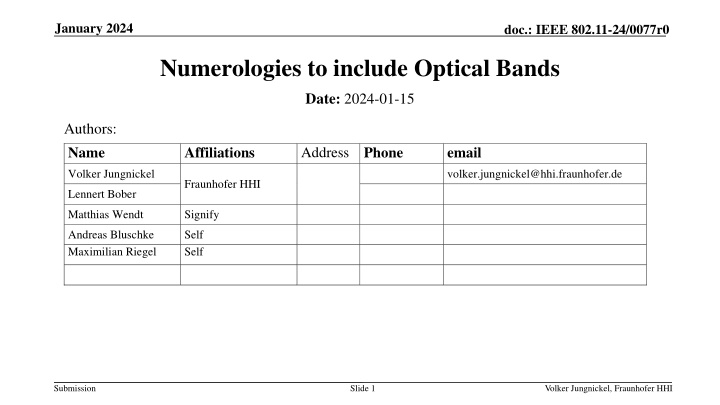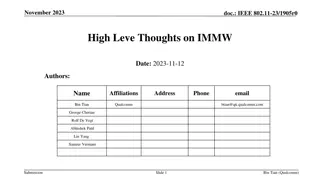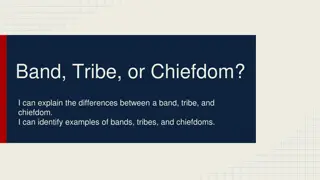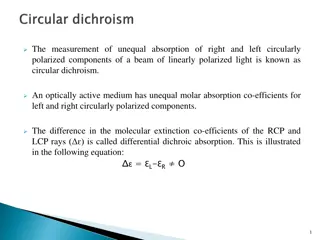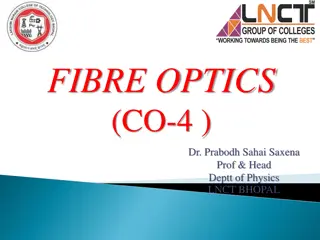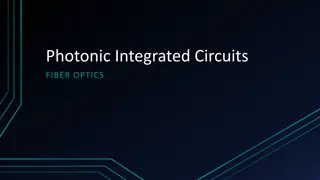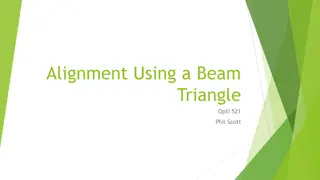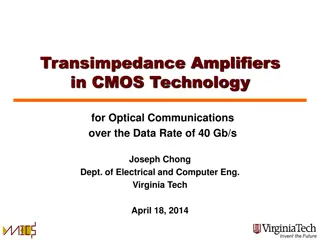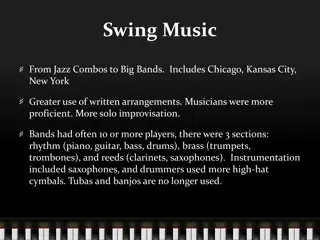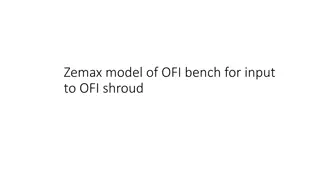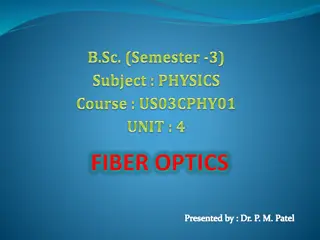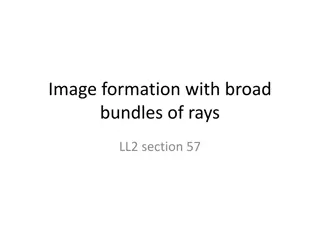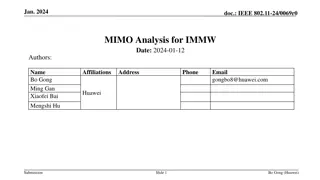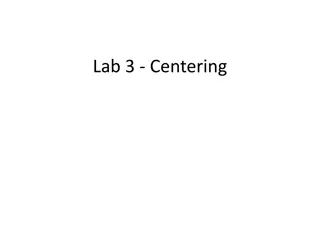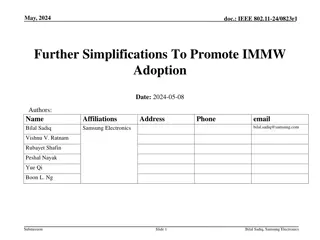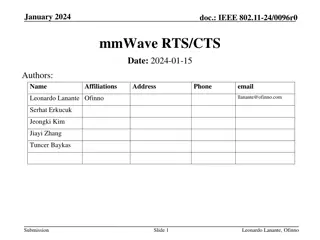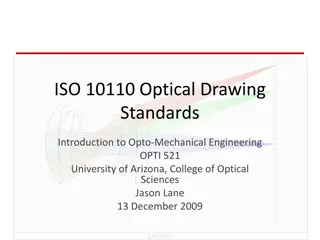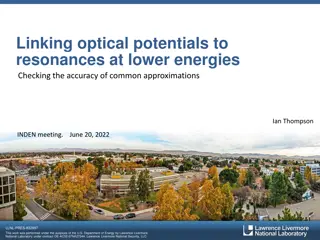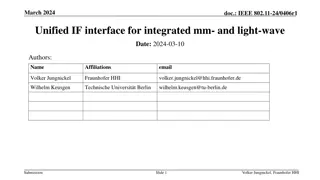Numerologies in Optical Bands for IMMW Scope
This document explores the inclusion of optical bands into the IMMW scope through numerologies, encompassing both sub-7GHz and mm-wave bands. It discusses previous work, RMS delay spread, channel coherence time, and potential implications on performance and range.
Download Presentation

Please find below an Image/Link to download the presentation.
The content on the website is provided AS IS for your information and personal use only. It may not be sold, licensed, or shared on other websites without obtaining consent from the author.If you encounter any issues during the download, it is possible that the publisher has removed the file from their server.
You are allowed to download the files provided on this website for personal or commercial use, subject to the condition that they are used lawfully. All files are the property of their respective owners.
The content on the website is provided AS IS for your information and personal use only. It may not be sold, licensed, or shared on other websites without obtaining consent from the author.
E N D
Presentation Transcript
January 2024 doc.: IEEE 802.11-24/0077r0 Numerologies to include Optical Bands Date: 2024-01-15 Authors: Name Affiliations Address Phone email Volker Jungnickel volker.jungnickel@hhi.fraunhofer.de Fraunhofer HHI Lennert Bober Matthias Wendt Signify Andreas Bluschke Maximilian Riegel Self Self Submission Slide 1 Volker Jungnickel, Fraunhofer HHI
January 2024 doc.: IEEE 802.11-24/0077r0 Abstract This contribution considers numerologies to include optical bands into the IMMW scope. Both, the original numerology from sub-7GHz and the up- clocked numerology for mm-wave bands may be supported in optical bands. Submission Slide 2 Volker Jungnickel, Fraunhofer HHI
January 2024 doc.: IEEE 802.11-24/0077r0 Previous work and this contribution Recent contributions in IMMW SG show significant interest in use of higher bands [1-4] proposed to reuse existing sub-7GHz baseband waveforms [5, 6] proposed a limited scope to minimize effort in general [7] discussed beacon issues [8] proposed to extend the scope and include optical bands [9, 10] provide background on 11bb in optical bands this approach can only work if parts of the standard are reused Numerology is critical issue definitions for optical bands to be proposed Submission Slide 3 Volker Jungnickel, Fraunhofer HHI
January 2024 doc.: IEEE 802.11-24/0077r0 RMS delay spread Most application scenarios are inside buildings light propagation is via dominant line-of-sight (LOS) minor diffuse reflections at walls and objects NLOS is 20 30dBel below LOS signals [11] light propagation is limited to a single room, walls are opaque Source: https://ieeexplore.ieee.org/abstract/document/8864131 [11] 11bb channel models longest path delay is 100 ns in industrial scenario RMS delay spreads are below 20 ns [12] Cyclic prefix can be very short 100 ns as proposed for mm-wave may work very well impact on performance to be evaluated Source: 11-18/1582r4, IEEE 802.11bb Reference Channel Models for Indoor Environments [12] Submission Slide 4 Volker Jungnickel, Fraunhofer HHI
January 2024 doc.: IEEE 802.11-24/0077r0 Channel coherence time Other than mm-wave, LC applies frequency up-shift to LC IF instead of mm-wave RF [9, 10] max. Doppler shift ? =? ???is proportional to carrier frequency?? 1 2? ? channel coherence time ?? Source: https://astro.ucla.edu/~wright/doppler.htm Examples mm-wave ??= 60 000 MHz, optical ??=176 2416 MHz, v=1 m/s ?? = 150 s ??= 300 22 ms v=1 m/s ? = 180 Hz, ? = 0.5 7.2 Hz, Optical channel maybe 150 x 2000 x less time variant compared to mm-wave. higher MCS and more spatial streams maybe useful impact on performance/range to be evaluated Submission Slide 5 Volker Jungnickel, Fraunhofer HHI
January 2024 doc.: IEEE 802.11-24/0077r0 Phase noise Phase noise depends on carrier frequency principal behaviour is the same but overall level is increased e.g. 4...40 GHz: 20 dB when frequency increases 10x Examples mm-wave band @ ??= 60000 MHz SSB PN +28 dB compared to Wi-Fi@2.4 GHz optical band @ ??=176 (2416) MHz SSB PN -22 0 dB compared to Wi-Fi@2.4 GHz Source: https://www.edn.com/impact-of-phase-noise-in-signal-generators/ Optical channel may have 30 50 dB less phase noise compared to mm-wave. higher MCS and more spatial streams maybe useful impact on performance/range to be evaluated Submission Slide 6 Volker Jungnickel, Fraunhofer HHI
January 2024 doc.: IEEE 802.11-24/0077r0 Implications on numerology Optical bands can use the same cyclic prefix like mm-wave. delay spread is small enough Optical bands do not necessarily need to increase carrier spacing. significantly lower Doppler frequencies and phase noise higher MCS and more spatial streams maybe useful Optical bands can be considered transparent . i.e., both, the original numerology from sub-7GHz and the up-clocked numerology derived from sub-7GHz for mm-wave bands can be supported in optical bands Submission Slide 7 Volker Jungnickel, Fraunhofer HHI
January 2024 doc.: IEEE 802.11-24/0077r0 Summary In order to maximize reuse of HW/SW, numerologies should be aligned with mm-wave when including optical bands. Both, the original numerology from sub-7GHz and the up-clocked numerology derived from sub-7GHz for mm-wave bands can be supported in optical bands. Submission Slide 8 Volker Jungnickel, Fraunhofer HHI
January 2024 doc.: IEEE 802.11-24/0077r0 References Integrated mmWave Design Considerations, doc. 11-23/1819r1 https://mentor.ieee.org/802.11/dcn/23/11-23-1819-01-immw-integrated-mmwave-design-considerations.pptx [1] High-Level Design Considerations of IMMW, 11-23/1878r1, https://mentor.ieee.org/802.11/dcn/23/11-23-1878-01-immw-high-level-design-considerations-of-immw.pptx [2] [3] Requirements Analysis for IMMW Use Cases, 11-23/1977r1, https://mentor.ieee.org/802.11/dcn/23/11-23-1977-01-immw-requirements-analysis-for-immw-use-cases.pptx [4] Discussion on Enabling MIMO in IMMW, 11-23/1991r, https://mentor.ieee.org/802.11/dcn/23/11-23-1991-00-immw-discussion-on-enabling-mimo-in-immw.pptx [5] Technical scope proposal, 11-23/2004r0, https://mentor.ieee.org/802.11/dcn/23/11-23-2004-00-immw-technical-scope-proposal.pptx [6] High-level thoughts on IMMW, 11-23/1905r0, https://mentor.ieee.org/802.11/dcn/23/11-23-1905-00-immw-high-level-thoughts-on-immw.pptx [7] mmWave operation without mmWave Beacon, 11-23/2152r0, https://mentor.ieee.org/802.11/dcn/23/11-23-2052-00-immw-mmwave-operation-without-mmwave-beacon.pptx [8] Extend IMMW scope to include optical bands, 11-23/2016r2, https://mentor.ieee.org/802.11/dcn/23/11-23-2016-02-immw-extend-immw-scope-to-include-optical-bands.pptx [9] IEEE Std 802.11bb-2023, https://standards.ieee.org/ieee/802.11bb/10823/ [10] IEEE 802 Tutorial IEEE 802 Standards on Light Communication at March 2023 Plenary Meeting https://mentor.ieee.org/802.11/dcn/23/11-23-0277-01-0000-ieee-802- standards-on-light-communication.pdf [11] Sreelal M. Mana et al., "Experiments in Non-Line-of-Sight Li-Fi Channels," 2019 Global LIFI Congress (GLC), Paris, France, 2019, https://ieeexplore.ieee.org/document/8864131 [12] 11-18/1582r4, IEEE 802.11bb Reference Channel Models for Indoor Environments , https://mentor.ieee.org/802.11/dcn/18/11-18-1582-04-00bb-ieee-802-11bb-reference- channel-models-for-indoor-environments.pdf [13] 11-23/0221r1 Hybrid LC and RF in UHR https://mentor.ieee.org/802.11/dcn/23/11-23-0221-01-0uhr-hybrid-lc-and-rf-in-uhr.pptx [14] 11-23/0091 New Light Communication Features https://mentor.ieee.org/802.11/dcn/23/11-23-0091-00-0wng-light-communication-for-uhr.pptx Submission Slide 9 Volker Jungnickel, Fraunhofer HHI
